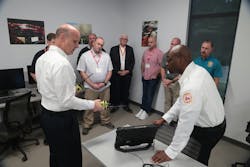Bridging the Gap: Leveraging Technology to Overcome Training Challenges
By Matt Shronts
As time passes, the fire service evolves. While calls for service continue to increase, the frequency of structure fire responses—the very incidents that built our collective experience and critical decision-making abilities—declines. As a result, training never has been more important, while being more challenging to deliver. Throughout my career, I’ve had the opportunity to tackle the challenges that many departments face, such as limited resources, time constraints and the logistical hurdles of providing meaningful, consistent training to career, combination and volunteer firefighters. Bridging the gap between traditional training methods and the opportunities that technology provides is pivotal to fire departments’ success.
By leveraging hybrid education models, realistic simulations and performance analytics, we can create dynamic training environments that prepare firefighters more efficiently.
Technology doesn’t replace hands-on drills; it enhances them by providing measurable outcomes, accessible learning opportunities, and decision-making statistics that directly translate to improved safety and operational effectiveness.
Through real-world examples and lessons learned, the session will explain how adopting these tools has allowed me to deliver better training outcomes while maintaining the integrity of the fire service.
Together, we can build a model of training that honors our past and embraces the future.
Takeaways
- Departments can enhance training outcomes by aligning technology-driven education with real-world job performance requirements.
- Integrating technology into training strengthens operational readiness and enhances firefighter safety while focusing on serving the community.
- Data-driven decision-making allows for more accessible, cost-effective and impactful firefighter training, while enhancing the service output to residents.
I Just Want the Damn Thing to Do What I Need It To: Understanding the Tech You Need and Want
By John Oates
The fire service is inundated increasingly by technological solutions whose developers promise everything from enhanced operational efficiency to improved firefighter health.
The sheer volume of options can be overwhelming for officers and chiefs.
At its core, the mission of the fire service remains a simple one: put water on fire. However, selecting, funding, and implementing technology quickly can become a complex and frustrating process.
All too often, after carefully weighing options, allocating funds and acquiring a solution, departments discover that the product doesn’t perform as expected or fails to meet their actual needs. The result is wasted resources, disappointed users and strained vendor relationships.
How can departments avoid these pitfalls? Although there is no one-size-fits-all answer, three strategies can help to guide decision-making.
Takeaways
- Don’t be distracted by the “shiny object.” Instead, clearly define what your department is trying to achieve. Is time saved? Are costs reduced? Is performance improved? How will the solution benefit the community? Consider whether the technology truly is an improvement compared with current practices or simply a different way of doing the same thing. Assess short-term gains and long-term effect and question whether the need is genuine or manufactured.
- A sales team will tell you its product is “the best.” Make those people prove it and
ask to evaluate it through the lens of your department, not the polished scenario that they present. - Technology isn’t just about the initial investment. Departments also must account for installation, training, customer support, warranties and opportunities for feedback. A product that performs well on Day 1 but lacks ongoing support quickly can become a liability. A strong post-purchase partnership is as important as the tool itself.
Leading into Tomorrow: People‑First Leadership in an AI World
By Eloy Vega
Artificial intelligence (AI) will continue to arrive in firehouses one workflow at a time. The decisive factor won’t be the algorithm; it will be the leader. AI can sharpen size-ups, speed decisions and direct resources where risk will rise. At the same time, we also confront the limits: bias in data, privacy obligations, AI hallucinations and the danger of overreliance.
Technology won’t carry a Halligan, comfort a family or accept accountability. People will.
I use two scenarios in this session: dispatch recommendations that will conflict with a veteran dispatcher’s judgment, and a community meeting that will question AI-assisted inspections and look at what a “human in the loop” will look like under pressure.
Participants will blend AI’s speed with judgment, set thresholds for override, and craft plain‑language answers about privacy, fairness and transparency. The goal won’t be to promote AI tools. Rather, it will be to strengthen leadership habits that keep innovation aligned with duty and trust.
We will close with a question-and-answer session, sharing of experiences, and exploring ideas on how to safely and ethically deploy AI in the fire service.
When we lead with integrity, communicate clearly and measure what matters, AI will become a force multiplier for safety, not a shortcut around judgment.
Takeaways
- Leaders will keep humans accountable and in control. If an AI output isn’t explainable, it won’t be deployable.
- Teams and stakeholders will be engaged early, trained continually and invited to give feedback, because trust drives adoption.
- Agencies should start with manageable AI solutions, measure their outcomes, and audit for bias and privacy. Then, they can share results to sustain community confidence.
About the Author
Peter Matthews
Editor-in-Chief/Conference Director
Peter Matthews is the conference director and editor-in-chief of Firehouse. He has worked at Firehouse since 1999, serving in various roles on both Firehouse Magazine and Firehouse.com staffs. He completed an internship with the Rochester, NY, Fire Department and served with fire departments in Rush, NY, and Laurel, MD, and was a lieutenant with the Glenwood Fire Company in Glenwood Landing, NY. Matthews served as photographer for the St. Paul, MN, Fire Department and currently is a photographer for the Fort Worth, TX, Fire Department.

